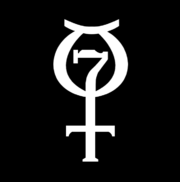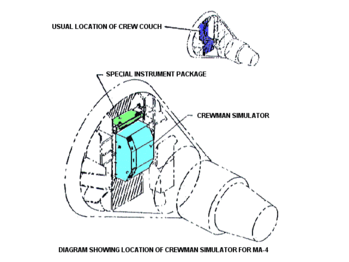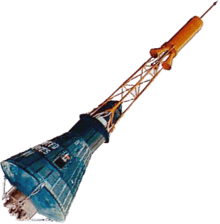Mercury-Atlas 4
_1.jpg) The launch of Mercury-Atlas 4 | |||||
| Mission type | Test flight | ||||
|---|---|---|---|---|---|
| Operator | NASA | ||||
| Harvard designation | 1961 Alpha Alpha 1 | ||||
| SATCAT № | 183 | ||||
| Mission duration | 1 hour, 49 minutes, 20 seconds | ||||
| Distance travelled | 41,919 kilometers (26,047 mi) | ||||
| Orbits completed | 1 | ||||
| Spacecraft properties | |||||
| Spacecraft | Mercury No.8 | ||||
| Manufacturer | McDonnell Aircraft | ||||
| Launch mass | 1,224.7 kilograms (2,700 lb) | ||||
| Start of mission | |||||
| Launch date | September 13, 1961, 14:04:16 UTC | ||||
| Rocket | Atlas LV-3B 88-D | ||||
| Launch site | Cape Canaveral LC-14 | ||||
| End of mission | |||||
| Landing date | September 13, 1961, 15:53:36 UTC | ||||
| Orbital parameters | |||||
| Reference system | Geocentric | ||||
| Regime | Low Earth | ||||
| Perigee | 149 kilometers (80 nmi) | ||||
| Apogee | 240 kilometers (130 nmi) | ||||
| Inclination | 32.5 degrees | ||||
| Period | 88.38 minutes | ||||
| Epoch | September 13, 1961[1] | ||||

| |||||
Mercury-Atlas 4 was an unmanned spaceflight of the Mercury program. It was launched on September 13, 1961 at 14:09 UTC from Launch Complex 14 at Cape Canaveral, Florida. A Crewman Simulator instrument package was aboard. The craft orbited the Earth once.

At this time, NASA was getting increasingly frustrated with the Atlas's poor launch record. Of four Mercury-Atlas flights so far, two (MA-1 and MA-3) had been total failures. One (Big Joe) had been a partial success and the otherwise completely successful MA-2 had experienced propellant slosh problems. In addition, the Atlas had not performed well in unmanned programs either as three Atlas-Able lunar probe launches in 1959–60 had all failed. The Air Force was also experiencing problems with military launches as a MIDAS early warning satellite and a SAMOS photoreconnaissance satellite launched with Atlas‑Agenas both failed to orbit during 1960. Only a few days before the flight of MA‑4 in September 1961, an Atlas‑Agena carrying a SAMOS satellite fell back on the launch pad at Vandenberg AFB, producing a spectacular explosion. Atlas ICBM tests at this time were still routinely failing as well.
These incidents produced a series of confrontations between NASA and Convair, the builders of the Atlas. As August 1961 ended, there had been 14 Atlas space launches (SCORE, Big Joe, the three Atlas-Able flights, Midas 1-3, Samos 1-2, Mercury-Atlas 1, Mercury-Atlas 2, Mercury-Atlas 3, and Ranger 1). Of these, eight were total losses and one had been a partial failure, yielding a 30% success rate. Convair argued that many of the failed Atlas space launches were due to faults of the upper stages or payload rather than the Atlas itself and on this point were correct. Only Big Joe and MA-3 could be directly blamed on a malfunction of the Atlas and the former's problems still did not preclude the mission from carrying out most of its goals. In any case, Atlas was hardly alone in reliability issues; the other workhorse of the US space program, Thor, had a launch record that was scarcely better.
There were a series of delays getting the Atlas and Mercury capsule ready, because the postflight findings from MA-3 had necessitated extensive modifications to the booster. Vehicle 88D did not undergo its factory rollout inspection until June 30 and delivery to the Cape waited until July 15. Moreover, the flight was not going to use Mercury capsule #9 as planned, but instead capsule #8, which had been recovered from the MA‑3 launch and refurbished. Capsule #8 was also the last of the older models with small port windows, no landing bag, and a heavy locking mechanism on the hatch.
Further delays happened when it was discovered that the brand of transistor used in both the Atlas and Mercury were prone to forming solder balls, thus the entire last week of August was spent laboriously repairing them.[2]
In August, the Soviet Union orbited cosmonaut Gherman Titov in Vostok 2 for a day‑long flight, producing stunned disbelief in the US and paranoia in some quarters as Soviet premier Nikita Khrushchev proclaimed in a speech afterwards "We have launched Gagarin and Titov into space, and we can deliver a nuclear weapon to any point on the planet!"
This flight was an orbital test of the Mercury Tracking Network and the first successful orbital flight test of the Mercury program. (All previous successful launches were suborbital) The payload consisted of a pilot simulator (to test the environmental controls), two voice tapes (to check the tracking network), a life support system, three cameras, and instrumentation to monitor levels of noise, vibration and radiation. Because it was suspected that a transient voltage caused the malfunction of MA‑3's programmer (and that a similar problem had been responsible for Big Joe's failure to stage), Convair equipped the autopilot to give the engines a counteracting capability.
The launch went extremely well and the thick-skinned Atlas survived Max Q acceleration. Capsule performance was also good despite some concern over high oxygen usage in orbit, however, ground controllers did not consider it a serious problem and the oxygen supply was sufficient for at least 8 orbits. The process of turning the capsule around in orbit so its heat shield faced forward proved more difficult than expected, taking 50 seconds instead of the normal 20 seconds. At a few points during the mission, the capsule's attitude became slightly unstable due to the failure of two thrusters, which caused momentary telemetry dropouts. Reentry took place one hour and 28 minutes after launch, and splashdown occurred in the Atlantic Ocean 176 miles (283 kilometers) east of Bermuda. The capsule was recovered by the destroyer USS Decatur in good condition with little damage from either liftoff, orbit, or reentry. Postflight examination found that the oxygen rate handle had been dislodged by liftoff-induced vibration and cracked open a valve. This had allowed oxygen to escape into space, but not at sufficient rates to trigger a telemetry warning measurement, although it did trigger the oxygen warning light in the capsule. The handle was redesigned afterwards to be more difficult to move. The problem reorienting the capsule after booster separation was found to be the result of an open circuit in the pitch gyro.
The biggest problem encountered on MA-4 was an uncomfortably high level of liftoff vibration from T+5 to T+20 seconds, so a few more small modifications were made to the Atlas's autopilot. However, Manned Spaceflight Center director Bob Gilruth expressed his confidence that the booster was now man-rated, and that a human passenger would have survived the flight. Nonetheless, to be on the safe side and test out a few more design changes, NASA still planned for one more unmanned test before committing the Mercury-Atlas combo to a manned flight.
Thus, testing this was also an objective of the flight. It demonstrated the ability of the Atlas LV-3B rocket to lift the Mercury capsule into orbit, of the capsule and its systems to operate completely autonomously, and succeeded in obtaining pictures of the Earth. It completed one orbit prior to returning to Earth. The capsule was recovered 176 miles east of Bermuda. One hour and 22 minutes after splashdown the destroyer USS Decatur (which was 34 miles from the landing point) picked up the capsule. On the MA‑4 mission, all flight objectives were successfully achieved.
See also
References
- ↑ McDowell, Jonathan. "SATCAT". Jonathan's Space Pages. Retrieved March 23, 2014.
- ↑ http://history.nasa.gov/SP-4201/ch12-1.htm
![]() This article incorporates public domain material from websites or documents of the National Aeronautics and Space Administration.
This article incorporates public domain material from websites or documents of the National Aeronautics and Space Administration.
